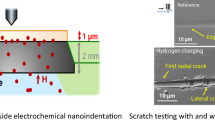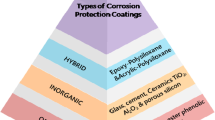Abstract
The conditions of metal hydride formation are studied during the cathodic reduction of metals through the parallel reactions of the Men+ and H+ cations. It is established that this interaction is possible not only through the introduction and localization of a hydrogen atom in the metal structure (e.g., in interstices). The hydrides can also be formed in areas of metal structure defects. The energy of hydrogen-metal interaction in metallurgy is shown to be different from that which takes place in electroplating. Thus, we have observed certain mechanisms of hydrogen interaction with electrolytic metals and alloys. We have shown the exceptional role of structural defects in causing the formation of metal-hydrogen bonds. It is found that stable defects can be applied for the accumulation of hydrogen in the form of hydrides.
Similar content being viewed by others
References
McKay, K., Hydrogen Compounds of Metals, Springer, 1966.
Galaktionova, N.A., Vodorod v metallakh (Hydrogen in Metals), Moscow: Metallurgiya, 1967.
Gel’d, P.V., Ryabov, R.A., and Mokhracheva, L.P., Vodorod i fizicheskie svoistva metallov i splavov. Gidridy perekhodnykh metallov (Hydrogen and Physical Property of Metals and Alloys. Hydrides of Transition Metals), Moscow: Nauka, 1985.
Oudriss, A., Creus, J., Bouhattate, J., Conforto, E., Berziou, C., Savall, C., and Feugas, X., Grain size and grain-boundary effects on diffusion and trapping of hydrogen in pure nickel, Acta Materialia, 2012, no. 60, pp. 6814–6828.
Sudzuki, K, Fudzimori, X., and Khasimoto, K., Amorfnye metally (Amorphous Metals), Moscow: Metallurgiya, 1987.
Alefeld, G. and Volkl, J., Hydrogen in Metals I: Basic Properties, Springer Berlin Heidelberg, 2014.
Alefeld, G. and Volkl, J., Hydrogen in Metals II, Springerlink, 2012.
Fromm, E. and Uhcida, H., Surface phenomena in hydrogen absorption kinetics of metals and intermetallic compounds, J. Less-Common Metals, 1987, no. 131, pp. 1–12.
Chene, I., Contribution of cathodic charging to hydrogen storage in metal hydrides, J. Less-Common Metals, 1987, no. 131, pp. 337–347.
Libowitz, G.G. and Maeland, A.J., Hydride formation by BCC solid solution alloys, Mater. Sci. Forum, 1988, vol. 31, pp. 176–196.
Pick, M.A., Green, V.G., and Strongin, M., Uptake rates for hydrogen by niobium and tantalum: Effect of thin metallic overlayers, J. Less-Common Metals, 1980, no. 73, pp. 89–95.
Pick, M.A., Davenpor, J.W., Strongin, M., and Dienes, G.J., Enhancement of hydrogen uptake rate for Nb and Ta by thin surface overlayers, Phys. Rev. Lett., 1979, vol. 43, no. 4, pp. 286–289.
Osnovy vodorodnoi energetiki (Fundamentals of Hydrogen Energetics), Moshnikova, V.A. and Terukova, E.I., Eds., St. Petersburg: SPb Gos. Tekh. Univ., Len. Ekonom. Tekh. Inst., 2011.
Poltoratskii, L.M., Gromov, V.E., and Chinokalov, V.Ya., Vodorod v stalyakh i splavakh (Hydrogen in Steels and Alloys), Novokuznetsk: Sib. Gos. Industr. Univ., 2008.
Kuznetsov, V.V., Khaldeev, G.V., and Kichigin, V.I., Navodorazhivanie metallov v elektrolitakh (Hydrogen Treatment of Metals in Electrolytes), Moscow: Mashinostroenie, 1993.
Kolachev, B.A., Vodorodnaya khrupkost’ metallov (Hydrogen Fragility of Metals), Moscow: Metallurgiya, 1985.
Archakov, Yu.A., Vodorodnaya korroziya stali (Hydrogen Corrosion of Steel), Moscow: Metallurgiya, 1985.
Beloglazov, S.M., Elektrokhimicheskii vodorod i metally. Povedenie, bor’ba s okhrupchivaniem (Electrochemical Hydrogen and Metals. Behavior and Fragility Control), Kaliningrad: Kaliningrad. Gos. Univ., 2004.
Povetkin, V.V. and Kovenskii, I.M., Structura elektroliticheskikh pokrytii (The Structure of Electrolytical Coatings), Moscow: Metallurgiya, 1989.
Grankin, E.A., Shalimov, Yu.N., and Ostrovskaya, E.N., The dependence of internal friction of electrolytic chromium on the modes of electrocrystalization, Altern. Energ. Ecol., 2004, no. 7, pp. 12–18.
Zvyagintseva, A.V., Interaction peculiarities of hydrogen and Ni-B galvanic alloys, Carbon Nanomaterials in Clean Energy Hydrogen Systems, Springer, 2008, pp. 437–442.
Afanas’ev, V.V. and Zaikov, G.E., Fizicheskie metody v khimii (Physical Methods in Chemistry), Moscow: Nauka, 1984.
Karyakin, N.I., Bystrov, K.N., and Kireev, P.S., Kratkii spravochnik po fizike (A Short Handbook on Physics), Moscow: Vysshaya Shkola, 1964.
Elementarnyi uchebnik fiziki (Elementary Schoolbook on Physics), Landsberg, G.S., Ed., Moscow: Nauka, 1964.
Gamburg, Yu.D., Elektrokhimicheskaya kristallizatsiya metallov i splavov (Electrochemical Crystallization of Metals and Alloys), Moscow: Yanus-K, 1997.
Gamburg, Yu.D., Semenov, V.P., Dubovkin, N.F., and Smirnov, L.N., Spravochnik po vodorodu, svoistvam, polucheniyu, transportirovaniyu, primeneniyu (A Handbook on Hydrogen, Its Properties, Obtaining, Transportation, Application), Gamburg, Yu.D. and Dubovkin, N.F., Eds., Moscow: Khimiya, 1989.
Shalimov, Yu.N., Litvinov, Yu.V., and Mandrykina, I.M., Optimizatsiya elektrokhimicheskogo protsessa obrabotki alyuminievoi fol’gi v proizvodstve kondensatorov (Optimization of Electrochemical Process of Treatment of Aluminum Foil in Manufacturing Capacitors), Voronezh: Voronezh. Gos. Tekh. Univ., 2000.
Blanter, M.S., Piguzov, Yu.V., et al., Metod vnutrennego treniya v metallovedcheskikh issledovaniyakh (The Method of Internal Treatment in Physicometallurgical Studies), Moscow: Metallurgiya, 1991.
Postnikiv, V.S., Vnutrennee trenie v metallakh (Internal Friction in Metals), Moscow: Metallurgiya, 1974.
Gel’d, P.V., Ryabov, R.A., and Kodes, E.S., Vodorod i nesovershenstva struktury metalla (Hydrogen and Structural Imperfections of Metal), Moscow: Metallurgiya, 1979.
Novik, A. and Berri, B., Relaksatsionnye yavleniya v kristallakh (Relaxation Phenomena in Crystals), Nadgornyi, E.M. and Soifer, Ya.M., Eds., Moscow: Atomizdat, 1975.
Bekman, I.N., Fenomenological description of diffusion in defective media, Fizika, khimiya i mekhanika poverkhnosti. Vzaimodeistvie vodoroda s metallami (Physics, Chemistry and Mechanics of Surface. Interaction of Hydrogen with Metals), Zakharov, A.P., Ed., Moscow: Nauka, 1987.
Lyubov, B.Ya., Diffuznye izmeneniya defeknoi structury tverdykh tel (Diffusion Changes in Defective Structures of Solid Bodies), Moscow: Metallurgiya, 1985.
Grankin, E.A., Shalimov, Yu.N., and Ostrovskaya, E.N., Hydrogen treatment of electrolytic sediments of chromium, nickel and their alloys, Altern. Energ. Ecol., 2005, no. 6, pp. 13–17.
Zvyagintseva, A.V., Interrelation of structure and properties of electroplated coatings alloyed with boron in the electronic articles, Galvanotekh. Obrab. Poverkh., 2007, vol. XV, no. 1, pp. 16–22.
Krishtal, M.A., Piguzov, Yu.V., and Golovin, S.A., Vnutrennee trenie v metallakh i splavakh (Internal Friction in Metals and Alloys), Moscow: Metallurgiya, 1964.
Shalimov, Yu.N., Gusev, A.L., Kharchenko, Yu.V., Litvinov, E.L., and Kudryash, V.I., Classic and alternative approaches to interaction of hydrogen with metals during electrochemical reduction on the cathode, Altern. Energ. Ecol., 2007, vol. 8, no. 52, pp. 35–42.
Aleksandrov, L.N. and Mordyuk, V.S., Vnutrennee trenie i fizicheskie svoistva tugoplavkikh metallov (Internal Friction and Physical Properties of Refractory Metals), Saransk: Mordov. Knizh. Izd., 1965.
J. Friedel, Dislocations, Paris: Gauthier-Villars, 1956.
Kudinov, G.M. and Lyubov, B.Ya., The influence of structural defects on diffusion of interstitial impurities in metals, Fiz. Met. Metalloved., 1981, vol. 51, no. 6, pp. 1297–1300.
Zvyagintseva, A.V., The dependence of interaction of metals with hydrogen on the structure of electrochemical systems, Uchenye zapiski Tavricheskogo nats. Univ. Vernadskogo. Ser. biologiya, khimiya, 2013, vol. 26, no. 65, pp. 259–269.
Gusev, A.L., Shalimov, Yu.N, and Kharchenko, E.L., Peculiarities of mechanisms of formation of hydrogen compounds of metals in electrochemical systems, Altern. Energ. Ecol., 2007, vol. 3, no. 47, pp. 43–54.
Vlasov, N.M. and Zvyagintseva, A.V., Matematicheskoe modelirovanie vodorodnoi pronitsaemosti metallov (Mathematical Modeling of Hydrogen Permeability of Metals), monograph, Voronezh: Voronezh. Gos. Tekh. Univ., 2012.
Author information
Authors and Affiliations
Corresponding author
Additional information
Original Russian Text © A.V. Zvyagintseva, Yu.N. Shalimov, 2014, published in Elektronnaya Obrabotka Materialov, 2014, No. 6, pp. 13–24.
About this article
Cite this article
Zvyagintseva, A.V., Shalimov, Y.N. On the stability of defects in the structure of electrochemical coatings. Surf. Engin. Appl.Electrochem. 50, 466–477 (2014). https://doi.org/10.3103/S106837551406012X
Received:
Accepted:
Published:
Issue Date:
DOI: https://doi.org/10.3103/S106837551406012X




